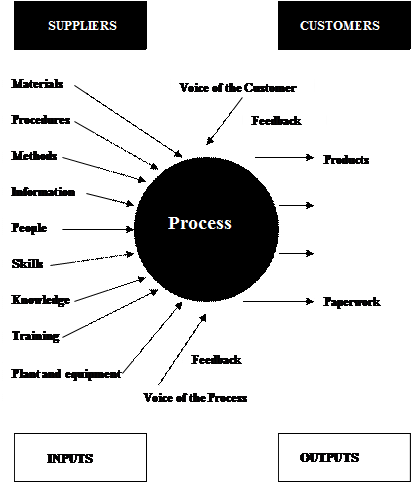Fig. 3.1. Total Quality Management
3.____ There exists in each department, each office, each home, a series of customers, suppliers and customer-supplier interfaces. These are “the quality chains”, and they can be broken at any point by one person or one piece of equipment not meeting the requirements of the customer, internal or external. The failure usually finds its way to the interface between the organisation and its external customer, or in the worst case, actually to the external customer. Failure to meet the requirements in any part of a quality chain has a way of multiplying, and failure in one part of the system creates problems elsewhere, leading to yet more failure and problems, and so the situation is exacerbated. The ability to meet customers’ (external and internal) requirements is vital. As well as being fully aware of customers’ needs and expectations, each person must respect the needs and expectations of their suppliers. The ideal situation is an open partnership style relationship, where both parties share and benefit.
4. ____ TQM is an approach to improving the competitiveness, effectiveness and flexibility of an organisation for the benefit of all stakeholders. It is a way of planning, organising and understanding each activity, and of removing all the wasted effort and energy that is routinely spent in organisations. It ensures the leaders adopt a strategic overview of quality and focus on prevention not detection of problems. A fundamental requirement is a sound quality policy, supported by plans and facilities to implement it. Leaders must take responsibility for preparing, reviewing and monitoring the policy, plus take part in regular improvements of it and ensure it is understood at all levels of the organisation. Effective leadership starts with the development of a mission statement, followed by a strategy, which is translated into action plans down through the organisation. These, combined with a TQM approach, should result in a quality organisation, with satisfied customers and good business results. The following is a list of points that leaders should consider; they are a distillation of the various beliefs of some of the quality gurus: · the organisation needs a long-term commitment to continuous improvement; · adopt the philosophy of zero defects to change the culture; · train people to understand the customer/supplier relationships; · do not buy products or services on price alone – look at the total cost; · adopt modern methods of supervising and training – eliminate fear; · eliminate barriers between departments by managing the process – improve communications and teamwork; · eliminate goals without methods, standards based only on numbers, barriers to pride of workmanship and fiction – get facts by studying processes; · constantly educate and retrain – develop experts in the organization; · develop a systematic approach to manage the implementation of TQM. 5. ___ Total Quality Management means that the organization's culture is defined by and supports the constant attainment of customer satisfaction through an integrated system of tools, techniques, and training. This involves the continuous improvement of organizational processes, resulting in high quality products and services. The culture in any organization is formed by the beliefs, behaviour, norms, dominant values, rules and the ‘climate’. A culture change, e.g. from one of acceptance of a certain level of errors or defects to one of right first time (zero defects), every time, needs two key elements: 1) commitment from the leaders; 2) involvement of all of the organization’s people. 6. ____ Organizations everywhere, of all types and sizes, are under constant pressure to improve their business performance, measure themselves against world class standards and focus their efforts on the customer.

|




